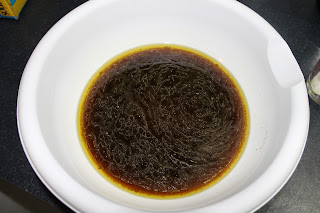In my pioneer post, I mentioned laughing with (at) us and learning from our mistakes. Well I have one to share with you now. A couple months ago when I first became interested in making my own cleaning products, I went out and purchased supplies. Since then I've been (im)patiently waiting to run out of things. I was so excited when we ran out of laundry detergent that I'm not sure it wasn't weird.
Slowly but surely I've been building up my arsenal of natural homemade products...with few successes. A DIYer can't be afraid of failure. If you're inclined to try any of these things yourself, I don't want to just tell you what works, I also want to tell you what doesn't work.
Did you know that you (probably) aren't buying soap at the store? Read your labels. It's not dish soap, or laundry soap, or bar soap. It's detergent - dish detergent, laundry detergent, or just bar (beauty bar, cleansing bar). These things can't be called soap because soap only results from the chemical reaction called saponification. When distilled water, sodium or potassium hydroxide (lye) and fats and oils come together in specific ratios, they saponify, becoming something new - soap. Detergents are synthetic foaming and cleansing agents that are cheaper to manufacture, hence their widespread use.
The first soap we (my sister and I) tried was laundry soap. I'm not going to share recipes until I try things that actually work, but what we used in our laundry soap was a combination of grated Fels Naptha, castile, Borax (sodium borate), baking soda (sodium bicarbonate) and washing soda (sodium carbonate). Sodium, who knew? Half of those things I had never heard of before and had a bit of an adventure trying to find locally. Fels Naptha is a laundry bar soap that was developed in 1893. I probably won't use it again because it contains fragrance and dyes. Castile is soap that originated in Spain with references as early as 1616. It is traditionally made from olive oil, but now refers to soap that is made from a combination of olive oil and other vegetable oils instead of animal fats (tallow and lard). Borax, baking soda and washing soda are natural cleansers, deodorizers and water softeners.
 So. We grated the soap. Tim almost ate some, thinking it was cheese. We melted the grated soap in purified hot water, whisked in the "dry ingredients," then slowly added an additional 2 gallons of purified water while continuing to whisk. It's supposed to thicken overnight to a gel-like consistency. What we ended up with was a 2 inch thick disk of rather stiff foam sitting on top of soapy water. Going back to the comments on the blog I was using as a resource, I realized that where we probably went wrong was the whisk. She uses a stick blender. I didn't have one of those, but I do now, and I am once again (im)patiently looking forward to running out of laundry soap. Our foam/water concoction still cleans, but it's a bit of a pain because you have to shake it well before use and try to get an appropriate ratio of foam/soapy water.
So. We grated the soap. Tim almost ate some, thinking it was cheese. We melted the grated soap in purified hot water, whisked in the "dry ingredients," then slowly added an additional 2 gallons of purified water while continuing to whisk. It's supposed to thicken overnight to a gel-like consistency. What we ended up with was a 2 inch thick disk of rather stiff foam sitting on top of soapy water. Going back to the comments on the blog I was using as a resource, I realized that where we probably went wrong was the whisk. She uses a stick blender. I didn't have one of those, but I do now, and I am once again (im)patiently looking forward to running out of laundry soap. Our foam/water concoction still cleans, but it's a bit of a pain because you have to shake it well before use and try to get an appropriate ratio of foam/soapy water.
I love to learn. I love to make things. I love knowing exactly what is in the soap that is cleaning my clothes. I also love saving money. I spent about $15 for all the ingredients. Our first batch made roughly 3 gallons of soap. I have enough bar soap left for another 3 gallon batch, and enough of the other ingredients for several more batches. We're talking pennies a load.
I'll keep you updated on our progress. Next time I'll try the stick blender. After that, I'm hoping to try making my own laundry bar soap for the recipe, but that's another blog post for another day.
-Kendra









